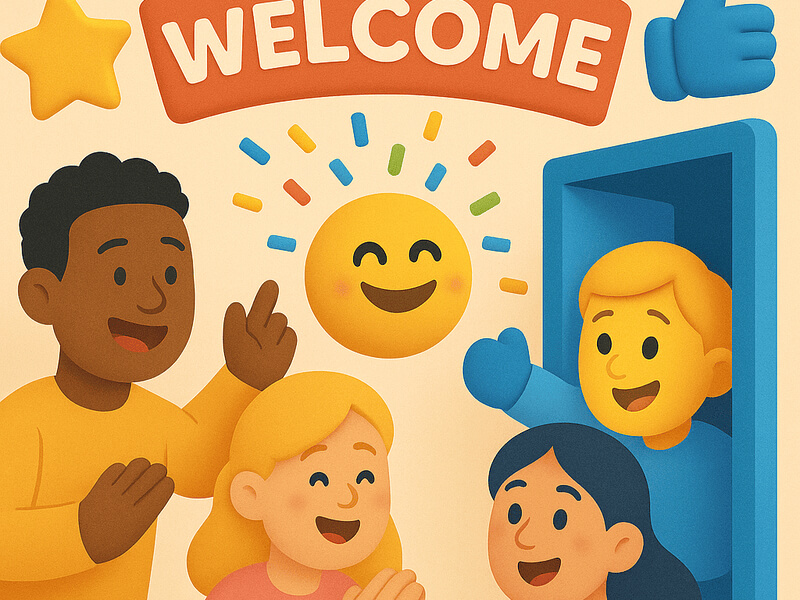
Creating meaningful recognition programs requires more than good intentions, as it demands strategic planning and structured processes. At Matter, we understand that organizations often struggle with inconsistent employee recognition nomination form processes, unclear criteria, and time-consuming paperwork that can discourage managers and team members from participating in recognition initiatives. These challenges can undermine even the most well-intentioned employee recognition efforts when employees lack access to proper nomination forms.
The solution lies in implementing well-designed employee nomination forms that streamline the entire process while ensuring fairness and transparency. When employees have clear guidance through standardized nomination forms on how to nominate their colleagues, it becomes easier to identify exemplary employees who deserve recognition for their hard work and significant contributions to the organization. The right employee recognition nomination form template can transform your recognition culture by making it simple for everyone to actively participate in celebrating workplace success through structured nomination processes.
What is an employee recognition nomination form?
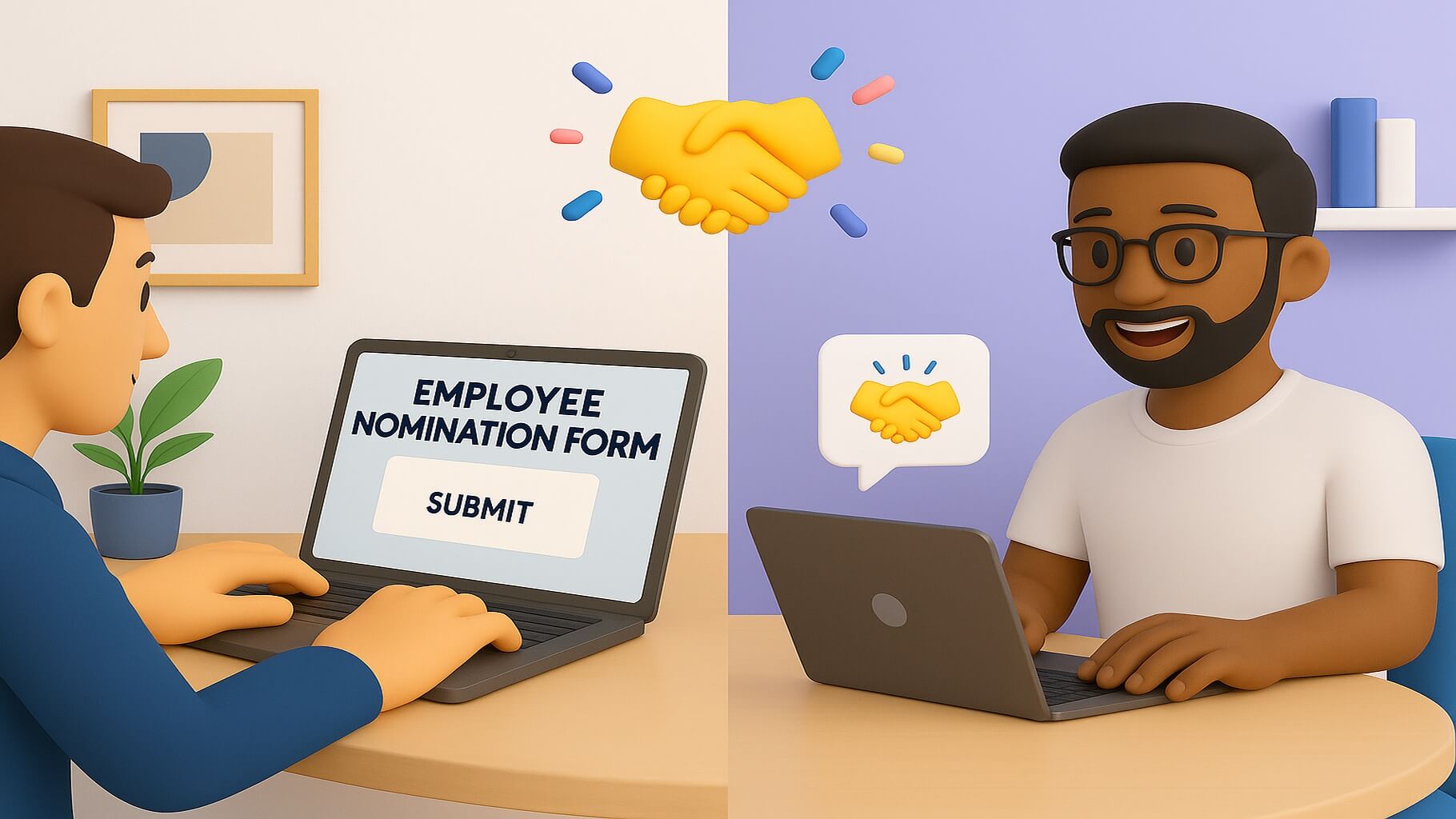
An employee recognition nomination form is a structured document that allows managers, peers, and team members to formally nominate colleagues for various awards and recognition programs. These forms serve as the foundation for fair and transparent recognition processes by capturing detailed information about an employee's contributions, achievements, and impact on the organization. The nomination process becomes more efficient when everyone understands exactly what information to provide and how their submissions will be evaluated.
Modern nomination forms can be digital tools integrated into HR systems or simple templates that can be customized for different recognition types. Whether you're implementing employee nomination programs for the first time or refining existing processes, the right form structure ensures consistent evaluation criteria across all submissions. Organizations that use standardized forms typically see higher participation rates and more meaningful recognition outcomes.
Essential components every nomination form for employee recognition should include
Every effective nomination form should contain specific fields that capture both quantifiable achievements and qualitative contributions. The nominator's information section should include their name, department, and relationship to the nominee, which helps establish credibility and context for the submission. Employee details must cover the nominee's name, position, department, and length of service to provide evaluators with necessary background information.
The achievement description section represents the heart of any nomination form, requiring specific examples of accomplishments, behaviors, or contributions that warrant recognition. This area should prompt nominators to describe how the employee's efforts impacted their team, customers, or the broader organization. Including fields for measurable outcomes helps create stronger cases for recognition while maintaining objectivity in the evaluation process.
Additional components should address the time period for the achievements, supporting documentation or evidence, and alignment with company values or recognition criteria. Many organizations also include sections for peer endorsements or manager approval to strengthen the nomination's credibility. These comprehensive elements ensure that review committees have all the necessary information to make informed decisions about award recipients.
Why structured forms improve nomination quality and consistency
Structured forms eliminate guesswork by providing clear guidelines for what constitutes a strong nomination, resulting in higher-quality submissions across all departments. When employees understand exactly what information to include, they can craft more compelling cases that highlight specific achievements rather than general praise. This consistency enables review committees to evaluate submissions fairly and identify the most deserving candidates through well-structured employee nomination sample approaches.
The standardized format also reduces bias by ensuring all nominations are evaluated against the same criteria regardless of who submits them. Managers become more confident in their ability to complete nominations when they have clear prompts and examples to guide their responses. This structured approach particularly benefits organizations with multiple locations or departments where recognition practices might otherwise vary significantly.
Furthermore, well-designed forms capture data that can be stored securely and analyzed over time to identify trends in recognition patterns and program effectiveness. Organizations can review which departments actively participate in nominations, identify the types of achievements that are most commonly recognized, and explore ways to enhance their overall recognition culture. This analysis helps leaders make informed decisions about program adjustments and resource allocation.
How nomination forms support fair and transparent recognition programs
Transparent nomination processes build trust by establishing clear criteria that all employees can understand and access regardless of their position or department. When the nomination form outlines specific requirements and evaluation standards, it eliminates perceptions of favoritism or hidden agendas in recognition decisions. Employees feel more confident that their efforts will be fairly considered when they understand how the process works.
The documentation provided by nomination forms creates an audit trail that supports decision-making and demonstrates the integrity of recognition programs. Review committees can reference specific examples and achievements when explaining their selections, which helps maintain credibility with all employees. This transparency is particularly important in larger organizations where employees may not personally know all award recipients.
Standardized forms also ensure that exemplary employees from all areas of the organization have equal opportunities for recognition, not just those with more vocal advocates or higher visibility roles. The structured format requires nominators to provide concrete evidence of achievements, which levels the playing field for employees who might otherwise be overlooked. This fairness fosters a stronger overall culture and encourages continued excellence across all teams.
Why employee recognition nomination forms are important

Recognition programs create a lasting impact when they operate through systematic processes that ensure fairness, consistency, and meaningful outcomes for all participants. Organizations without structured nomination processes often struggle with sporadic recognition, unclear criteria, and missed opportunities to celebrate significant contributions from dedicated team members. These challenges can lead to decreased morale and reduced employee engagement over time.
Effective nomination forms serve as the bridge between informal appreciation and formal recognition programs, providing the framework necessary to consistently identify and celebrate exceptional performance. When employees have clear pathways to nominate their colleagues, it fosters a culture where everyone feels empowered to recognize and reward hard work and innovation. The result is a more engaged workplace where employee nomination examples inspire others to strive for excellence.
Streamlining the recognition process with standardized forms
Standardized nomination forms eliminate confusion by providing clear templates that guide managers and team members through each step of the submission process. When everyone uses the same form structure, HR teams can process nominations more efficiently, ensuring that all required information is consistently captured. This streamlined approach reduces administrative burden and allows recognition programs to operate smoothly without overwhelming staff with complex procedures.
The uniform format also makes it easier to create digital tools that can automate parts of the nomination process, from submission reminders to status updates for nominators. Organizations can integrate these forms into their existing HR systems, creating seamless workflows that encourage participation without adding significant workload to managers' responsibilities. This efficacy is especially advantageous for organizations that operate multiple recognition programs concurrently or have a substantial workforce.
Additionally, standardized forms enable organizations to establish clear timelines and deadlines for nomination submissions, award notifications, and recognition ceremonies. Teams can plan recognition events more effectively when they know exactly when nominations will be complete and ready for review. This predictability helps maintain momentum in recognition programs, ensuring that deserving employees receive timely acknowledgment for their contributions.
Ensuring comprehensive evaluation through structured submissions
Structured forms prompt nominators to provide detailed information about achievements, making it easier for review committees to understand the full scope of an employee's contributions. Rather than relying on brief comments or general praise, these forms require specific examples, measurable outcomes, and context that demonstrates the nominee's impact on their team or organization. This comprehensive approach guarantees that all pertinent factors are considered during the evaluation procedure.
The detailed information captured through nomination forms also helps identify patterns in employee performance and organizational success stories that might otherwise go unnoticed. Review committees can spot trends in innovation, customer service excellence, or team collaboration that inform broader recognition strategies and employee rewards programs. This data becomes valuable for understanding what drives success within the organization.
Furthermore, comprehensive nominations provide rich content for recognition announcements and celebration events that highlight specific achievements rather than generic praise. When organizations can share detailed stories about the contributions of award recipients, it creates more meaningful recognition experiences and inspires other employees to pursue similar excellence. These detailed narratives also serve as examples for future nominators who want to understand what constitutes strong submissions.
Building accountability and transparency in recognition programs
Formal nomination forms create accountability by requiring nominators to provide specific evidence and examples to support their submissions, which encourages thoughtful consideration of who truly deserves recognition. This requirement helps prevent casual or unfounded nominations while ensuring that all submissions meet minimum standards for quality and relevance. The result is a more credible recognition program that maintains high standards and meaningful outcomes.
The documentation created through nomination forms also provides transparency by establishing clear records of why specific employees were selected for awards or recognition. Organizations can reference these records when communicating recognition decisions to the broader employee group, demonstrating that selections were based on merit and specific achievements. This transparency builds trust in the recognition process and encourages continued participation from all team members.
Moreover, the structured approach allows organizations to track participation patterns and ensure that recognition opportunities are distributed fairly across different departments, roles, and employee groups. Leaders can review nomination data to identify any gaps in participation and take proactive steps to encourage broader involvement in recognition programs. This ongoing analysis helps maintain an inclusive culture where all employees have equal access to recognition opportunities regardless of their visibility or position within the organization.
10+ employee recognition nomination form templates you can download

Organizations can simplify the implementation of effective recognition programs by utilizing proven form templates that can be tailored to their unique requirements and culture. These templates function as starting points that guarantee the inclusion of all necessary components while eliminating the guesswork associated with creating nomination forms from scratch. Whether you're launching new team rewards initiatives or refining existing processes, the right template provides the foundation for successful recognition programs.
The following collection of nomination form templates addresses different organizational sizes, recognition types, and implementation preferences. Each template includes fields for capturing detailed achievement information, supporting evidence, and evaluation criteria that help review committees make informed decisions about award recipients. These forms can be adapted for various recognition programs, from monthly employee spotlights to annual achievement awards, ensuring comprehensive coverage of employee nomination form requirements.
Simple employee recognition nomination form template for small businesses
Small organizations often need straightforward nomination forms that capture essential information without overwhelming busy managers or team members with complex requirements. This template focuses on the core elements needed to evaluate employee contributions while remaining easy to complete and process. The simplified format encourages participation by reducing the time commitment required for nominations while still gathering meaningful information about achievements.
Simple Recognition Nomination Form Template:
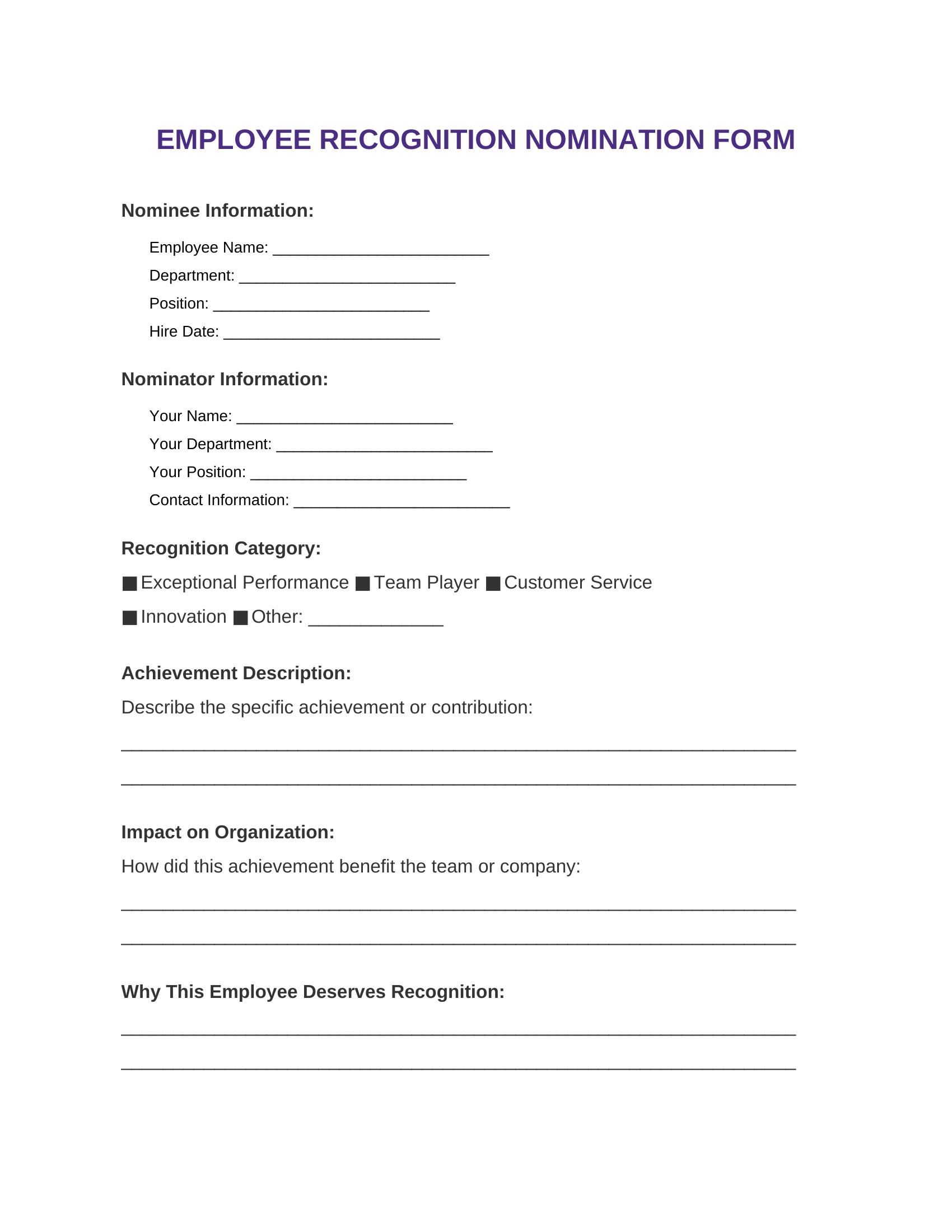
Link to Employee_recognition_nomination_form_10.pdf
Comprehensive employee recognition employee nomination form for large organizations
Large organizations require more detailed nomination forms that can capture complex achievements and provide sufficient information for committee review across multiple departments and employee levels. This comprehensive template includes sections for quantifiable results, cross-departmental impact, and alignment with organizational values that help evaluators compare diverse contributions fairly. The detailed format ensures that all relevant information is captured while maintaining consistency across different business units.
Comprehensive Recognition Nomination Form Template:
DETAILED EMPLOYEE RECOGNITION NOMINATION
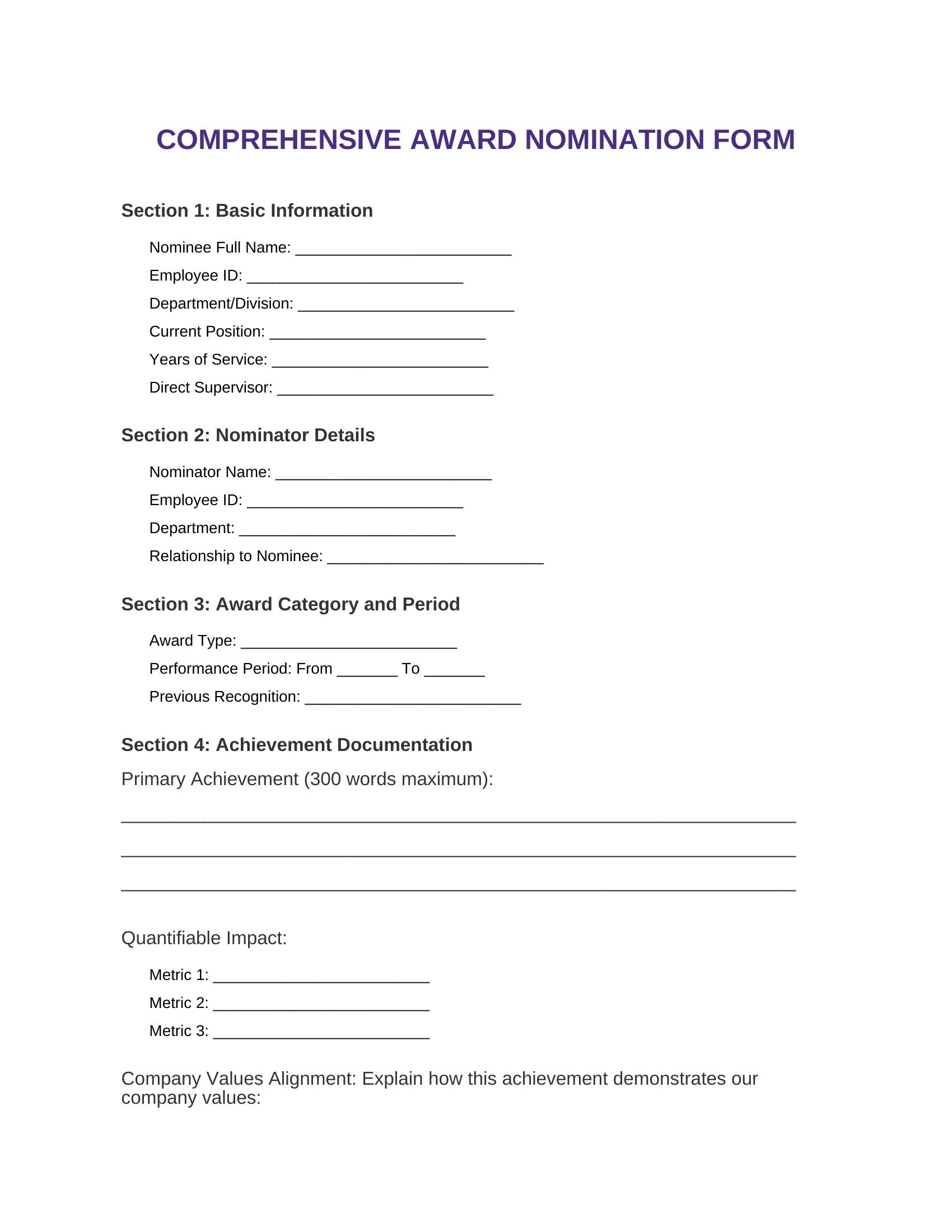
Link to Employee_recognition_nomination_form_9.pdf
Employee of the month nomination form template
Monthly recognition programs require focused forms that capture recent achievements and immediate impact within specific timeframes. This template emphasizes current performance while providing a clear structure for evaluating contributions that occurred within the nomination period. The format encourages timely recognition while maintaining consistent evaluation criteria across monthly cycles.
Employee of the Month Nomination Template:
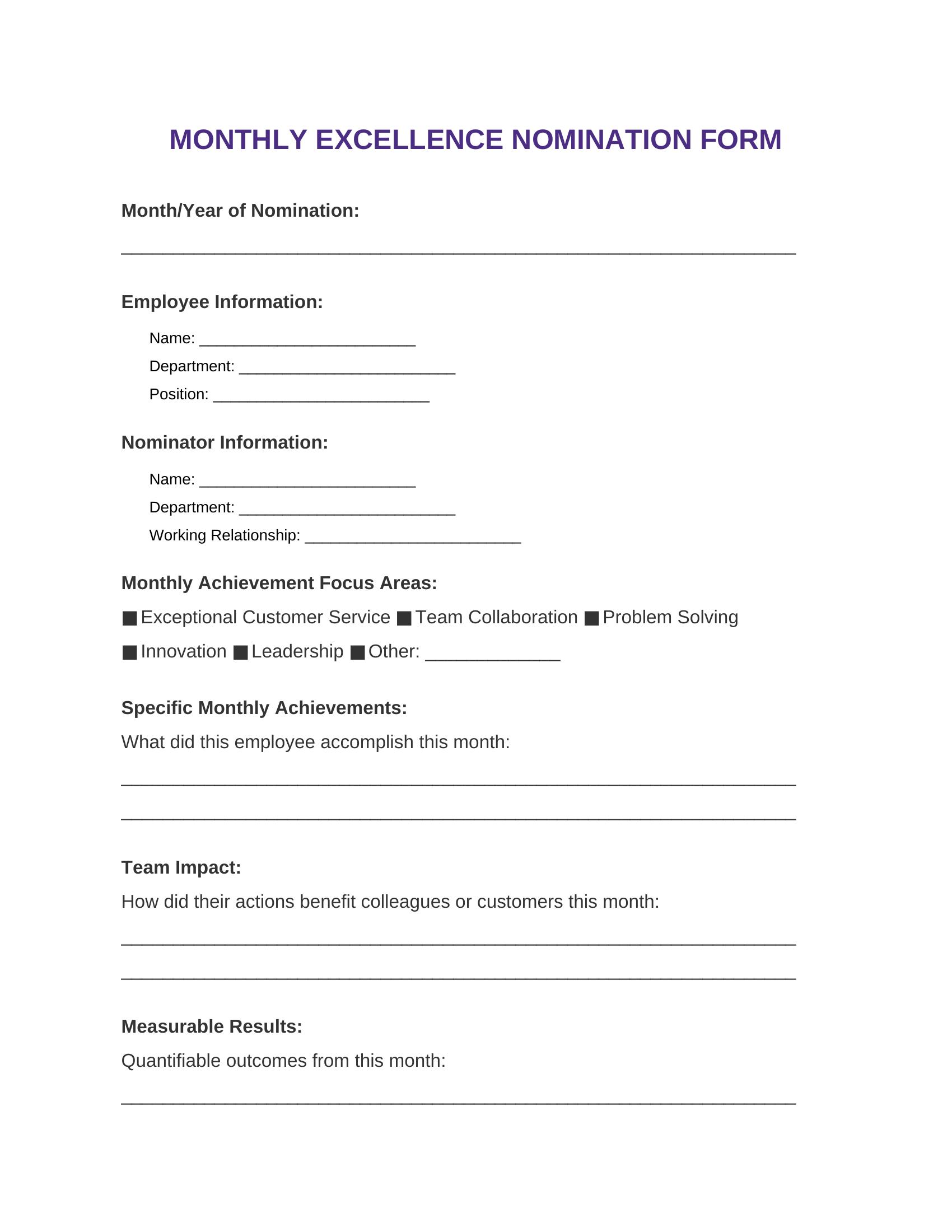
Link to Employee_recognition_nomination_form_8.pdf
Annual excellence award nomination form template
Annual recognition allows for a comprehensive evaluation of sustained performance and long-term contributions to organizational success. This template captures career development, major projects, and cumulative impact over extended periods. The format supports detailed assessment while accommodating multiple achievement examples throughout the evaluation year.
Annual Excellence Award Nomination Template:

Link to Employee_recognition_nomination_form_7.pdf
Peer-to-peer recognition nomination form template
Peer nominations capture collaborative excellence and colleague support that may not be visible to management. This template emphasizes teamwork, daily interactions, and the supportive behaviors that strengthen workplace relationships. The format encourages employees to recognize colleagues who contribute to positive team dynamics and collaborative success.
Peer-to-Peer Recognition Nomination Template:

Link to Employee_recognition_nomination_form_6.pdf
Manager-submitted nomination form template
Manager nominations leverage supervisory insights to document performance excellence and strategic contributions. This template captures goal achievement, leadership development, and organizational impact that supervisors observe through regular management oversight. The format enables a comprehensive assessment of employee potential and contribution patterns.
Manager-Submitted Nomination Template:
SUPERVISORY RECOGNITION NOMINATION
Customer service excellence nomination form template
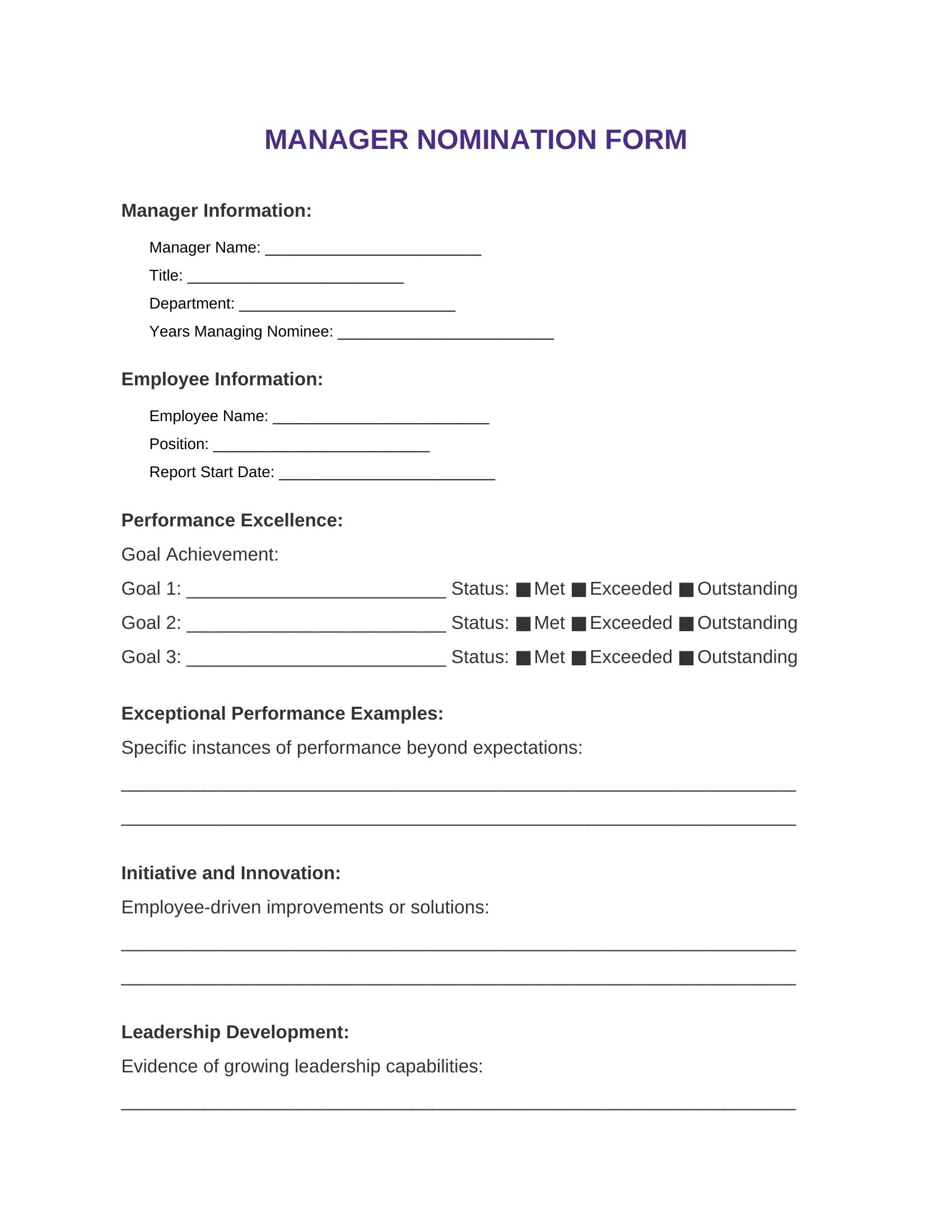
Link to Employee_recognition_nomination_form_5.pdf
Customer service nominations focus on client interactions, problem resolution, and contributions to customer satisfaction that directly impact organizational reputation. This template captures service delivery examples, customer feedback, and innovative approaches to client support. The format emphasizes customer impact and service excellence that drives business success.
Customer Service Excellence Nomination Template:
CUSTOMER SERVICE RECOGNITION NOMINATION

Link to Employee_recognition_nomination_form_4.pdf
Innovation and creativity award nomination form template
Innovation nominations recognize creative problem-solving, process improvements, and breakthrough ideas that advance organizational capabilities. This template documents the innovation process, implementation challenges, and measurable impact of creative contributions. The format captures both the creative thinking and practical application that drive organizational advancement.
Innovation and Creativity Award Nomination Template:
INNOVATION EXCELLENCE NOMINATION

Link to Employee_recognition_nomination_form_3.pdf
Team collaboration award nomination form template
Team collaboration nominations celebrate employees who excel at working with others and contributing to group success. This template captures collaborative behaviors, team support, and contributions to positive group dynamics. The format emphasizes relationship building and collective achievement that strengthens organizational effectiveness.
Team Collaboration Excellence Nomination Template:
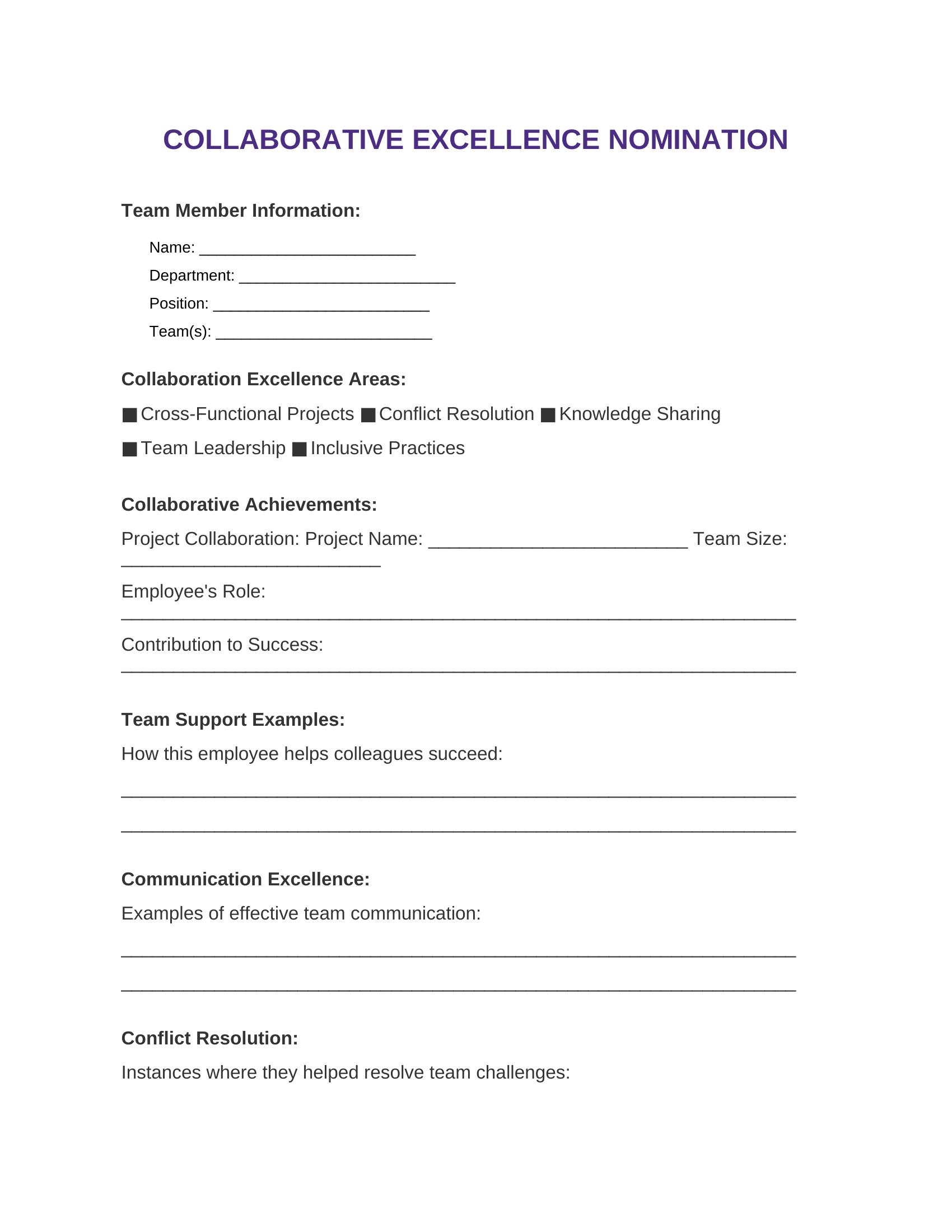
Link to Employee_recognition_nomination_form_2.pdf
Cross-departmental recognition nomination form template
Cross-departmental nominations recognize employees who facilitate collaboration across organizational boundaries and contribute to company-wide success. This template captures multi-functional achievements, relationship building across departments, and contributions that benefit the broader organization. The format emphasizes bridging skills and organizational citizenship.
Cross-Departmental Excellence Nomination Template:
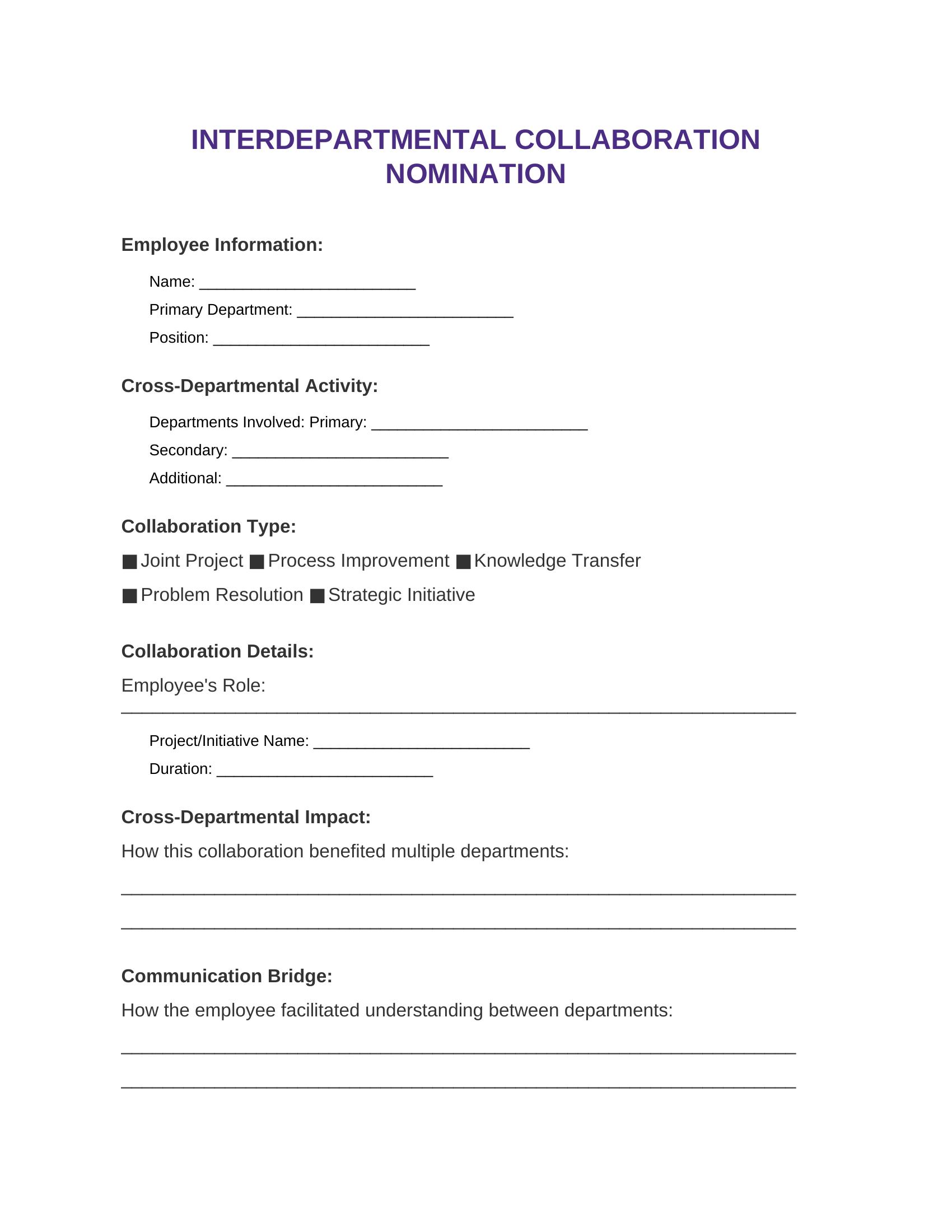
Link to Employee_recognition_nomination_form_1.pdf
8+ employee recognition nomination form examples for different awards
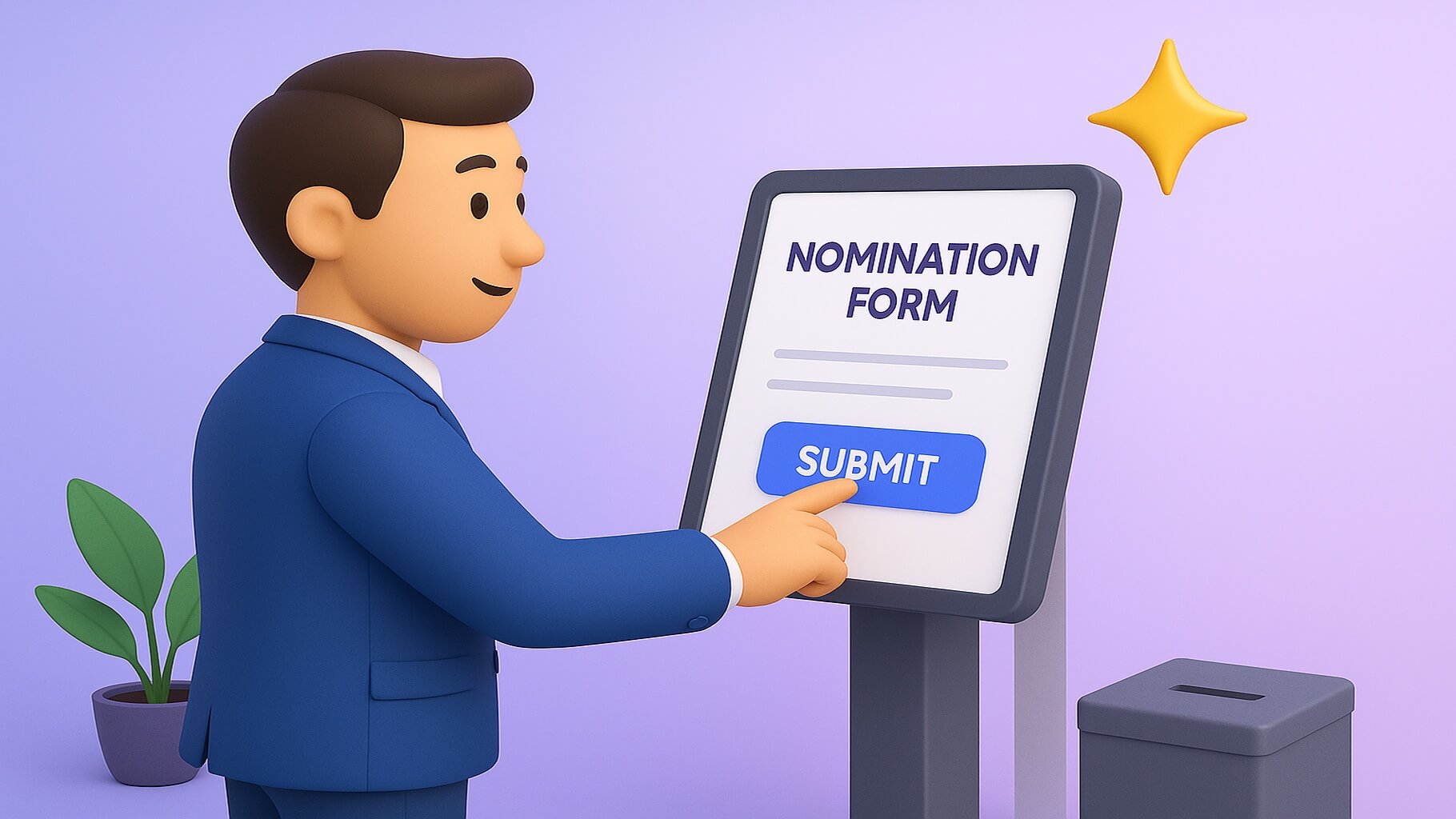
Different types of recognition programs require tailored nomination forms that address specific evaluation criteria and achievement categories relevant to each award type. Monthly recognition programs focus on recent accomplishments and immediate impact, while annual awards consider longer-term contributions and career development over extended periods. Understanding these distinctions helps organizations design forms that capture the most relevant information for each recognition opportunity.
The variety in nomination forms also reflects different organizational priorities and values, from customer service excellence to innovation and leadership development. Each award category requires specific prompts and evaluation criteria that guide nominators toward providing the most compelling evidence for their submissions. This targeted approach ensures that recognition programs effectively identify and celebrate the types of achievements that matter most to organizational success and employee rewards systems.
Employee recognition employee of the month nomination form samples
Monthly recognition programs require forms that focus on recent achievements and immediate impact rather than long-term career contributions. These forms should prompt nominators to describe specific accomplishments from the current month while providing context about how these achievements demonstrate exceptional performance. The evaluation criteria for monthly awards typically emphasize innovation, customer service, teamwork, or problem-solving that occurred within the designated time period.
Monthly nomination form elements include:
- Specific achievement date ranges to ensure submissions cover the appropriate time period
- Immediate impact descriptions focusing on recent contributions to team or customer success
- Peer collaboration examples highlighting teamwork and support provided to colleagues during the month
- Customer feedback or measurable outcomes that demonstrate the employee's exceptional performance
The monthly format requires forms that can be completed quickly while still capturing meaningful details about employee contributions and expenses. Organizations should design these templates to encourage regular participation by keeping the completion time reasonable while gathering sufficient information for fair evaluation. This balance helps maintain consistent monthly submissions while ensuring that deserving employees receive timely recognition for their recent achievements.
Annual employee recognition employee award nomination example forms
Annual recognition programs enable a more comprehensive evaluation of employee contributions over extended periods, necessitating nomination forms that capture career development, sustained excellence, and long-term impact on organizational success. These forms should include sections for multiple achievement examples, progression over time, and contributions that may have occurred across different projects or assignments throughout the year. The expanded scope requires more detailed documentation and evidence to support nomination submissions, similar to comprehensive employee-of-the-year nomination processes.
Annual award form components include:
- Comprehensive achievement timeline covering the full evaluation period with specific examples and dates
- Career development progression showing growth in skills, responsibilities, or leadership capabilities
- Cross-functional impact description highlighting contributions beyond the employee's immediate role or department
- Long-term value creation examples demonstrating sustained benefit to the organization over time
Annual forms benefit from including peer endorsement sections where multiple colleagues can provide supporting statements about the nominee's contributions throughout the year. This broader perspective helps evaluation committees understand the full scope of an employee's impact while gathering diverse viewpoints on their achievements. The comprehensive nature of annual nominations also provides valuable documentation for performance reviews and career development discussions.
Employee of the quarter nomination example form templates
Quarterly recognition strikes a balance between monthly immediacy and annual comprehensiveness, requiring forms that capture sustained performance over three months while maintaining focus on specific achievements and measurable outcomes. These forms should prompt nominators to provide examples of consistent excellence, project contributions, and collaborative efforts that demonstrate exceptional performance throughout the quarter. The evaluation period allows for more substantial achievements while remaining recent enough for detailed recollection.
Quarterly form structure includes:
- Project-based achievement sections focusing on major initiatives completed during the quarter
- Consistency indicators showing sustained high performance rather than single exceptional moments
- Team leadership examples demonstrating how the employee supported colleagues and contributed to group success
- Skill development evidence highlighting professional growth and learning during the evaluation period
The quarterly timeframe provides an opportunity to recognize employees who may not have achieved dramatic monthly results but consistently perform at high levels over extended periods. These forms should help nominators articulate patterns of excellence and cumulative impact that might be overlooked in shorter evaluation cycles. This approach ensures that reliable, steady performers receive appropriate recognition alongside colleagues who achieve more visible short-term successes.
Leadership excellence award nomination forms
Leadership excellence nominations require forms that capture an employee's ability to inspire, guide, and develop others while driving organizational results through effective decision-making and strategic thinking. These forms should document specific examples of leadership behavior, team development contributions, and instances where the nominee influenced positive outcomes through their leadership approach. The evaluation criteria focus on both formal and informal leadership contributions that demonstrate exceptional capability in guiding others toward success.
Leadership nomination elements include:
- Team development examples showing how the nominee mentored, coached, or supported colleagues' professional growth
- Decision-making instances highlighting strategic thinking and problem-solving that benefited the organization
- Vision and influence documentation demonstrating the nominee's ability to inspire others and drive positive change
- Results achievement evidence showing measurable outcomes directly attributable to the nominee's leadership efforts
Leadership forms should also capture the nominee's ability to navigate challenging situations, build consensus among diverse stakeholders, and maintain team morale during difficult periods. These nominations help organizations identify employees who possess the skills and characteristics necessary for future leadership roles, while also recognizing their current contributions to organizational success through effective leadership practices.
Innovation and creativity award nomination forms
Innovation and creativity award nominations focus on employees who contribute original solutions, creative approaches, or breakthrough ideas that advance organizational capabilities or competitive advantages. These forms should document the creative process, the challenges overcome during implementation, and the measurable impact of innovative contributions. The evaluation criteria emphasize originality, practical application, and the potential for broader organizational benefit from the nominee's creative work.
Innovation nomination components include:
- Creative solution documentation explaining the original problem and the innovative approach developed
- Implementation process description detailing how the idea was developed and brought to practical application
- Impact measurement evidence showing quantifiable benefits, improvements, or competitive advantages gained
- Scalability potential assessment demonstrating how the innovation could benefit other areas of the organization
Innovation forms should also recognize the risk-taking and persistence often required for successful creative work, as well as the nominee's ability to think beyond conventional solutions. These nominations help organizations identify and celebrate employees who advance organizational capabilities through innovative thinking while encouraging creative problem-solving throughout the workplace culture.
Customer service excellence award nomination forms
Customer service excellence nominations highlight employees who provide outstanding client experiences, address challenging customer situations, and enhance customer satisfaction and retention. These forms should document concrete examples of superior service delivery, client testimonials, and situations where the nominee exceeded standard service protocols. The evaluation criteria emphasize client impact, service enhancements, and the nominee's ability to positively represent the organization during customer interactions.
Customer service nomination features include:
- Superior service documentation capturing concrete situations where the nominee surpassed client expectations
- Customer feedback compilation, including testimonials, satisfaction scores, or direct customer praise
- Problem resolution evidence showing creative solutions to complex customer challenges
- Service improvement contributions highlighting process enhancements or innovations that benefited multiple customers
Customer service forms should also measure the impact on customer retention, repeat business, and overall satisfaction metrics, which demonstrate the nominee's contribution to organizational success through exceptional service delivery. These nominations help identify employees who directly influence customer loyalty and organizational reputation through their dedication to service excellence.
Team collaboration award nomination forms
Team collaboration award nominations celebrate employees who excel at working with others, facilitating group success, and contributing to positive team dynamics that enhance overall performance. These forms should document specific examples of collaborative behavior, team support, and instances where the nominee's participation elevated group achievements. The evaluation criteria emphasize relationship building, communication effectiveness, and contributions to team morale and productivity.
Team collaboration nomination elements include:
- Collaborative project examples showing how the nominee contributed to group success and team achievements
- Support documentation highlighting instances where the nominee helped colleagues overcome challenges or develop skills
- Communication effectiveness, evidence demonstrating the nominee's ability to facilitate productive team interactions
- Team morale contributions showing how the nominee's participation enhanced group dynamics and workplace culture
Team collaboration forms should also assess the nominee's ability to work effectively with diverse personalities, resolve conflicts constructively, and contribute to inclusive team environments where all members can thrive and succeed. These nominations help organizations recognize employees who strengthen team effectiveness through their collaborative approach and positive influence on group dynamics.
Performance improvement award nomination forms
Performance improvement award nominations recognize employees who have demonstrated significant growth, overcome challenges, or achieved remarkable progress in their professional development. These forms should document the baseline performance level, specific improvement efforts undertaken, and measurable results achieved through the nominee's dedication to growth and development. The evaluation criteria focus on progress trajectory, effort invested, and the positive impact of improved performance on organizational outcomes.
Performance improvement nomination components include:
- Baseline assessment documentation showing the starting point for improvement efforts
- Development activities description detailing training, coaching, or self-directed learning undertaken
- Progress measurement evidence showing quantifiable improvements in performance metrics or capabilities
- Impact demonstration explaining how the nominee's improvement benefited their team, department, or organization
Performance improvement forms should also acknowledge the dedication and persistence required for significant professional growth, as well as the nominee's willingness to seek feedback and adapt to change. These nominations help organizations celebrate employees who demonstrate commitment to continuous improvement while encouraging a culture of learning and development throughout the workplace.
Special achievement award nomination forms
Special achievement award nominations provide flexibility to recognize unique contributions, one-time accomplishments, or extraordinary efforts that don't fit traditional recognition categories. These forms should capture the exceptional nature of the achievement, the circumstances that made it particularly noteworthy, and the impact on organizational success. The evaluation criteria focus on the uniqueness of the contribution and its significance to the organization's mission or values.
Special achievement nomination features include:
- Unique contribution documentation explaining what made this achievement exceptional or unprecedented
- Circumstance description detailing the challenges or constraints that made the accomplishment particularly impressive
- Organizational impact evidence showing how the achievement benefited the company's mission, values, or strategic objectives
- Recognition justification explaining why this contribution deserves special acknowledgment outside normal recognition categories
Special achievement forms should also provide flexibility for nominators to describe achievements that may not have clear metrics or traditional success measures but represent significant value to the organization. These nominations help ensure that all types of exceptional contributions receive appropriate recognition while maintaining the flexibility to celebrate diverse forms of employee excellence.
How to create your own employee recognition nomination form template
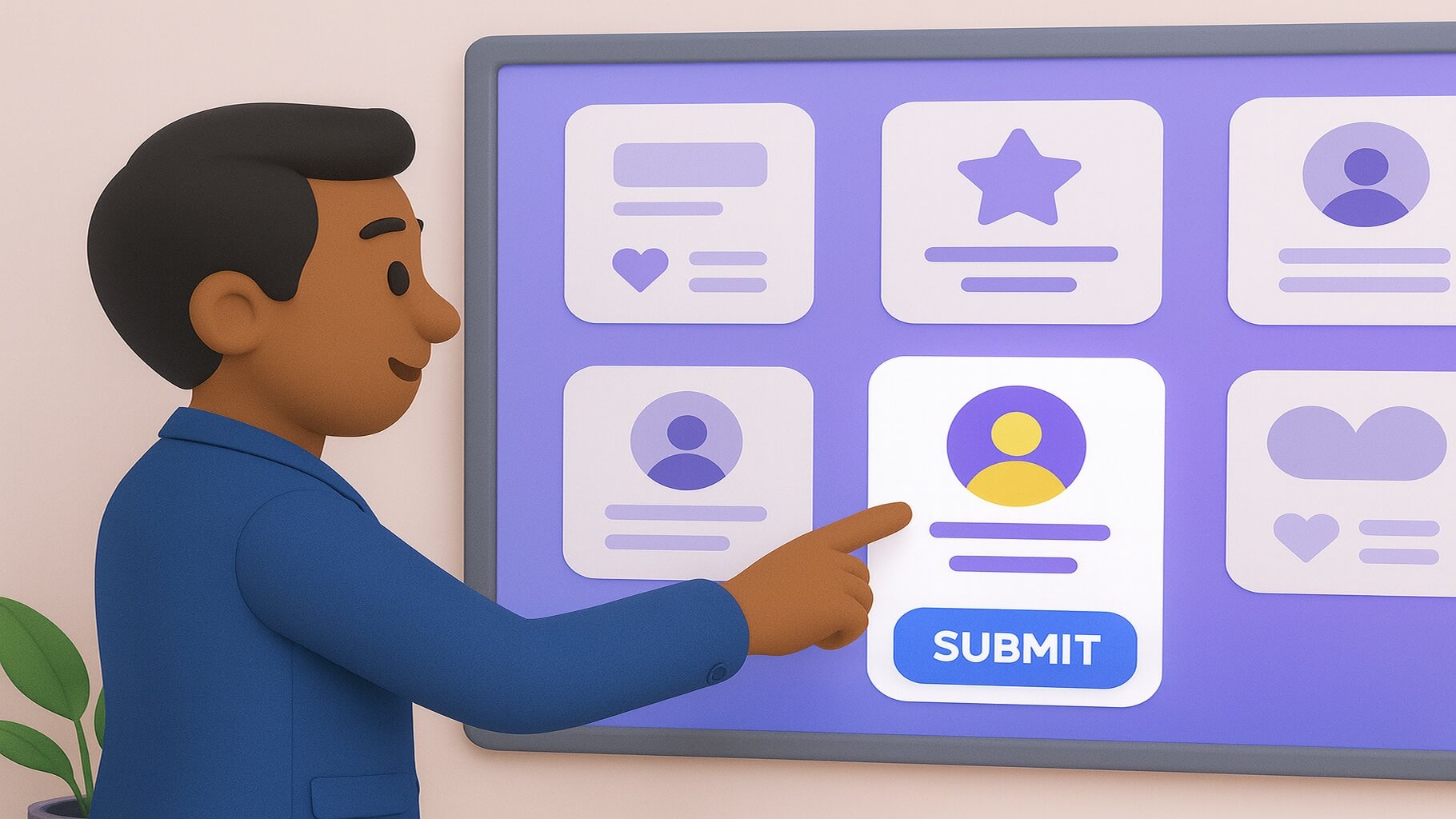
Developing customized nomination forms requires careful consideration of organizational culture, recognition program goals, and the specific types of achievements you want to celebrate through your employee rewards and recognition initiatives. The most effective forms reflect company values while providing clear guidance for nominators and comprehensive information for evaluation committees. This customization ensures that your recognition process aligns with broader organizational objectives and resonates with your unique workplace culture.
The development process include analyzing existing patterns of recognition, gathering feedback from managers and staff, and trying different formats to find the one that works best for your company. Consider factors such as employee comfort with technology, administrative capacity for processing nominations, and integration requirements with existing HR systems. The goal is to create forms that encourage participation while generating high-quality submissions that support meaningful recognition decisions.
Step-by-step guide to designing effective nomination forms
Begin by defining the specific recognition program goals and identifying what types of achievements and behaviors you want to encourage through the nomination process. This foundational step helps determine the essential fields and evaluation criteria that should be included in your form template. Consider surveying employees about their recognition preferences and reviewing successful nominations from informal recognition efforts to understand what information proves most valuable for evaluation purposes, including effective employee of the month nomination template designs.
Design process steps include:
- Conducting stakeholder interviews with managers, HR representatives, and potential nominators to understand their needs and preferences
- Analyzing existing recognition data to identify patterns in successful nominations and common gaps in submission quality
- Creating prototype forms with essential fields and testing them with small groups to gather feedback on usability and effectiveness
- Refining the template based on testing results and finalizing the format for broader organizational implementation
The iterative design approach allows you to incorporate feedback from actual users while ensuring that the final form meets both administrative requirements and user preferences. This collaborative process also builds buy-in from managers and employees who will be using the forms regularly. Testing different formats helps identify potential barriers to participation and allows you to address these concerns before full implementation.
Key fields and sections to include in your nomination form
Essential nomination forms should capture both factual information about achievements and contextual details that help evaluation committees understand the significance of employee contributions. The nominator information section establishes credibility and provides contact details for follow-up questions, while nominee details ensure accurate identification and provide relevant background information. Achievement descriptions form the core of any effective nomination, requiring specific examples with measurable outcomes where possible.
Critical form sections include:
- Contact and relationship information for both nominator and nominee to establish context and enable communication
- Detailed achievement descriptions with specific examples, dates, and measurable outcomes that demonstrate exceptional performance
- Impact assessment areas describing how the employee's contributions benefited their team, department, customers, or organization
- Supporting documentation fields for additional evidence, such as customer feedback, peer endorsements, or performance metrics
Additional considerations include sections for alignment with company values, collaboration examples, and professional development that provide a comprehensive view of the employee's contributions. Many effective forms also include fields for describing challenges overcome or innovative solutions developed, which help identify problem-solving abilities and resilience. The key is balancing comprehensive information gathering with form usability to encourage consistent participation.
Customizing forms to match your company culture and values
Successful nomination forms reflect organizational personality and priorities by incorporating language, criteria, and evaluation standards that resonate with your specific workplace culture. Companies emphasizing innovation should include fields for creative problem-solving and new idea development, while customer-focused organizations might prioritize service excellence and client relationship achievements. This alignment ensures that recognition programs reinforce the behaviors and outcomes that matter most to your organization's success through tailored employee-of-the-month nomination ideas.
Customization strategies include:
- Incorporating company-specific terminology and values language that employees recognize and understand
- Adding industry-relevant achievement categories that reflect the unique challenges and opportunities in your business sector
- Including fields for cultural contributions such as mentoring, volunteer work, or initiatives that strengthen workplace community
- Adapting evaluation criteria to emphasize the competencies and behaviors that drive success in your organizational context
The customization process should also consider communication preferences and technology comfort levels within your employee population. Some organizations benefit from informal, conversational forms of language, while others prefer more formal, structured approaches. Understanding your workforce demographics and preferences helps create forms that feel natural and accessible to all potential users, ultimately increasing participation rates and submission quality.
6+ specialized nomination forms for different recognition types

Recognition programs achieve greater impact when they address diverse contribution types and organizational roles through specialized nomination forms tailored to specific recognition categories. Different recognition types require unique evaluation criteria and examples of achievement that reflect the varying ways employees contribute to organizational success. Peer recognition focuses on collaboration and support, while leadership recognition emphasizes vision, decision-making, and team development capabilities that drive broader organizational outcomes.
Specialized forms also accommodate different organizational structures and reporting relationships by providing appropriate submission pathways and evaluation criteria for each type of recognition. Cross-departmental recognition celebrates collaboration across organizational boundaries, while role-specific recognition acknowledges achievements within particular functional areas. This diversity ensures that all employees have access to opportunities for recognition that align with their contributions and career development paths through targeted peer nomination processes.
Peer-to-peer employee recognition nomination form examples
Peer-to-peer recognition forms focus on collaborative achievements and support provided between colleagues at similar organizational levels, emphasizing teamwork, knowledge sharing, and mutual assistance that strengthen workplace relationships. These forms should prompt nominators to describe specific examples of helpfulness, collaboration, or encouragement that made their work easier or more successful. The evaluation criteria for peer recognition typically emphasize relationship building, providing problem-solving support, and making contributions to a positive workplace culture.
Peer recognition form features include:
- Collaboration examples describing specific instances where the nominee provided valuable assistance or expertise to colleagues
- Knowledge sharing documentation highlighting how the employee helped others learn new skills or overcome challenges
- Team support evidence showing contributions to group morale, communication, or collective problem-solving efforts
- Cultural impact descriptions explaining how the nominee's actions strengthened workplace relationships or community spirit
Peer forms benefit from informal language and accessible completion requirements that encourage regular participation from employees who may not be comfortable with formal nomination processes. The focus should remain on authentic appreciation and genuine examples of colleague support rather than formal achievement metrics. This approach helps capture the daily interactions and collaborative spirit that contribute significantly to workplace satisfaction and team effectiveness.
Manager-submitted employee nomination example forms
Manager-submitted nominations require forms that capture broader organizational impact and strategic contributions that supervisors are uniquely positioned to observe and evaluate. These forms should include sections for performance against goals, leadership development, initiative-taking, and contributions to departmental or organizational objectives that extend beyond basic job requirements. Managers can provide context about the challenges they have overcome, resource management, and decision-making that demonstrates exceptional employee capabilities, following proven examples of manager nomination.
Manager nomination components include:
- Performance excellence documentation showing achievement beyond standard expectations, with specific metrics where available
- Initiative and innovation examples describing employee-driven improvements, solutions, or new approaches that benefited the organization
- Leadership potential evidence highlighting mentoring, project management, or team building contributions that indicate future leadership capability
- Strategic alignment descriptions explaining how the employee's contributions support broader organizational goals and objectives
Manager forms should also include sections for professional development and growth that supervisors can observe over time, providing insights into employee progression and potential that peers might not fully appreciate. This perspective helps evaluation committees understand the nominee's trajectory and future value to the organization. Managers can also provide context about resource constraints, competing priorities, or other factors that make the employee's achievements particularly noteworthy.
Cross-departmental recognition nomination form templates
Cross-departmental recognition celebrates employees who break down silos and facilitate collaboration between different organizational areas, requiring forms that capture the complexity of multi-functional projects and relationship building across diverse teams. These nominations should emphasize communication skills, adaptability, and the ability to understand and bridge different departmental perspectives and priorities. The evaluation criteria focus on impact across organizational boundaries rather than achievement within a single functional area.
Cross-departmental form elements include:
- Multi-functional collaboration examples describing successful partnerships and joint initiatives across different organizational areas
- Communication effectiveness evidence showing the ability to translate concepts and requirements between departments with different expertise and priorities
- Problem-solving across boundaries, documentation highlighting solutions that required understanding and coordination of diverse departmental needs
- Relationship-building achievements demonstrating success in establishing trust and productive working relationships across organizational divisions
These forms should also capture the additional complexity and effort required to work effectively across departmental lines, including navigation of different processes, priorities, and communication styles. Evaluation committees need to understand how the nominee's contributions facilitated broader organizational success through improved coordination and collaboration. This recognition type particularly values employees who serve as connectors and facilitators in complex organizational environments.
Customer service excellence nomination forms
Customer service excellence nomination forms focus on exceptional client interactions, problem resolution, and contributions to customer satisfaction that directly impact organizational reputation and business outcomes. These forms should capture specific examples of going above and beyond normal service expectations, creative problem-solving for customer issues, and sustained commitment to customer satisfaction. The evaluation criteria emphasize customer impact, service innovation, and the ability to represent the organization positively in challenging situations.
Customer service nomination elements include:
- Exceptional service examples documenting instances where the employee exceeded customer expectations or resolved complex issues
- Customer feedback documentation, including testimonials, satisfaction scores, or specific praise from clients or customers
- Problem resolution evidence showing creative solutions to customer challenges or process improvements that enhanced service delivery
- Service innovation descriptions highlighting new approaches or improvements to customer service processes that benefited multiple clients
Customer service forms should also include sections for measuring impact on customer retention, satisfaction metrics, and examples of how the employee's service approach influenced positive business outcomes. These nominations help organizations recognize employees who directly contribute to customer loyalty and organizational reputation through their dedication to service excellence.
Innovation and problem-solving nomination forms
Innovation and problem-solving nomination forms recognize employees who contribute creative solutions, process improvements, or technological advances that benefit the organization. These forms should document the problem or challenge addressed, the creative approach taken, and the measurable impact of the solution. The evaluation criteria focus on originality, implementation success, and the broader applicability of the innovation to other areas of the organization, supporting effective problem-solving in business environments.
Innovation nomination components include:
- Problem identification documentation explaining the challenge or opportunity that prompted the innovative solution
- Solution development descriptions detailing the creative approach, resources used, and implementation process
- Impact measurement evidence showing quantifiable benefits, cost savings, efficiency improvements, or other positive outcomes
- Knowledge transfer examples demonstrating how the innovation was shared or applied to benefit other teams or departments
Innovation forms should also capture the risk-taking and persistence often required for successful innovation, as well as the employee's ability to think beyond conventional approaches. These nominations help organizations identify and celebrate employees who drive continuous improvement and competitive advantage through their creative problem-solving abilities.
Mentorship and development nomination forms
Employees who make a lasting influence beyond their own success by helping others advance their careers and skill sets are recognized through mentoring and development nomination forms. These forms should capture specific examples of teaching, coaching, or supporting colleagues' career advancement. The evaluation criteria emphasize the mentor's investment in others' success, the effectiveness of their development approaches, and the long-term impact on mentees' careers and capabilities.
Mentorship nomination features include:
- Teaching and coaching examples describing specific instances where the nominee helped others develop new skills or advance their careers
- Mentee impact documentation showing measurable improvements in skills, performance, or career progression resulting from the mentor's guidance
- Knowledge sharing evidence highlighting the nominee's commitment to transferring expertise and supporting others' professional development
- Leadership development contributions demonstrating the nominee's role in preparing others for increased responsibilities or leadership opportunities
Mentorship forms should also recognize the time and energy investment required for effective mentoring, as well as the long-term organizational benefits of developing talent from within. These nominations enable organizations to identify employees who contribute to talent retention and development, while fostering a culture of continuous learning and growth.
Employee of the month nomination example responses using forms

Effective nomination responses transform basic form templates into compelling cases for recognition by providing specific, detailed examples that demonstrate exceptional employee contributions and their impact on organizational success. These example responses serve as models for future nominators while illustrating how to articulate achievements in ways that resonate with evaluation committees. Strong responses combine factual information with narrative elements that help readers understand both what the employee accomplished and why those accomplishments deserve recognition through employee rewards examples.
The most compelling nomination responses address all form requirements while maintaining focus on specific achievements and measurable outcomes that distinguish the nominee from their peers. They provide context about challenges faced, solutions developed, and results achieved in ways that demonstrate exceptional performance rather than simply meeting job requirements. These examples help organizations understand what constitutes strong nominations while providing templates that other nominators can adapt for their own submissions.
Customer service excellence employee of the month nomination examples
Customer service recognition responses should highlight specific interactions, problem-solving efforts, and relationship-building achievements that demonstrate exceptional commitment to customer satisfaction and loyalty. These examples highlight situations where employees went above and beyond standard service protocols to achieve positive outcomes for customers, while upholding the organization's values and commitment to excellence. The most effective responses include specific customer feedback, measurable outcomes, and evidence of sustained service excellence over time.
Example customer service response elements: "This employee consistently demonstrates exceptional customer service through proactive problem-solving and genuine care for customer needs. During the nomination period, they successfully resolved a complex billing issue that had frustrated a longtime customer for several weeks. By coordinating with multiple departments and following up personally, they not only solved the immediate problem but also implemented a process improvement that prevented similar issues for other customers. The customer sent a written thank-you note praising the employee's persistence and professionalism, and their manager reports that customer satisfaction scores improved significantly during this period."
This response type provides specific examples while demonstrating broader impact on customer relationships and organizational reputation. The combination of individual achievement and systemic improvement shows exceptional contribution that extends beyond single interactions. Including customer feedback and measurable outcomes strengthens the nomination by providing external validation and quantifiable results that support the recognition decision.
Leadership and teamwork nomination letter examples through forms
Leadership recognition responses highlight situations where employees demonstrated exceptional guidance, mentoring, or team coordination that enabled group success and supported the development of their colleagues. These examples focus on informal leadership opportunities where employees took initiative to support their teams, facilitate communication, or drive collaborative solutions to challenging problems. The most compelling responses show how the nominee's leadership style positively influenced team dynamics and outcomes through effective peer-to-peer recognition of their contributions.
Example leadership response components: "This employee emerged as a natural leader during a challenging project that required coordination across multiple departments with conflicting priorities. They voluntarily organized weekly coordination meetings, created communication protocols that kept all stakeholders informed, and personally mentored two newer team members who were struggling with complex technical requirements. Their collaborative approach helped the project finish ahead of schedule while maintaining high-quality standards. Team members consistently seek their advice on complex problems, and their positive attitude during stressful periods helped maintain team morale and focus throughout the project."
Effective leadership responses demonstrate both task accomplishment and relationship building, showing how the nominee's influence extended beyond their individual contributions to enable broader team success. These examples should illustrate specific leadership behaviors and their impact on both project outcomes and the development of colleagues. The focus on voluntary leadership and peer recognition helps distinguish exceptional contributors from those simply fulfilling management responsibilities.
Innovation and problem-solving employee of the month nomination samples
Innovation recognition responses highlight creative solutions, process improvements, or new approaches that demonstrate exceptional thinking and initiative in addressing organizational challenges. These examples should describe specific problems faced, innovative solutions developed, and measurable outcomes achieved through creative thinking and persistent effort. The most compelling responses show how the nominee's innovation benefited not only their immediate work area but also broader organizational effectiveness and efficiency.
Example innovation response structure: "This employee identified a recurring problem with data entry errors that was causing delays and frustration across multiple departments. Rather than accepting this as an ongoing challenge, they researched the root causes and developed an automated validation system that detects errors before they are entered into the database. They collaborated with the IT department to implement the solution and trained colleagues on the new process. Since implementation, data entry errors have decreased by 75%, saving approximately 10 hours per week of correction time across the organization. Their initiative demonstrates both technical creativity and commitment to continuous improvement that benefits the entire team."
Strong innovation responses combine technical achievement with collaborative implementation and measurable organizational benefit. These examples should demonstrate both the creative thinking required to develop solutions and the practical skills needed to implement them successfully. Including specific metrics and broader impact helps evaluation committees understand the significance of the employee's contribution to organizational effectiveness and culture of innovation.
Best practices for implementing employee recognition nomination forms

Successful implementation of nomination forms requires comprehensive planning that addresses submission processes, evaluation criteria, training requirements, and ongoing program management to ensure consistent participation and meaningful outcomes. Organizations must establish clear procedures for distributing forms, setting completion deadlines, reviewing processes, and communicating results that create predictable workflows and maintain employee engagement. The implementation strategy should also address technology requirements, administrative responsibilities, and integration with existing HR systems and recognition programs, like effective employee of the month nomination processes.
Effective implementation goes beyond simply creating forms by establishing supporting systems that encourage participation, ensure fair evaluation, and celebrate recognition recipients in ways that reinforce program value and organizational culture. This comprehensive approach includes training nominators on best practices for completion, preparing evaluation committees for consistent review processes, and creating communication strategies that highlight recognition outcomes while encouraging continued participation. The goal is to establish sustainable practices that become integral to the organizational culture, rather than temporary initiatives.
Setting up submission processes and evaluation criteria
Clear submission processes eliminate confusion and ensure that nominations reach appropriate review committees within established timeframes while maintaining quality standards and fair evaluation opportunities. Organizations should establish specific deadlines, submission methods, and required documentation that create predictable schedules for both nominators and evaluation teams. The process should also address what happens to incomplete submissions, how to handle late nominations, and procedures for requesting additional information when needed.
Submission process components include:
- Standardized deadlines and submission methods that create predictable schedules for all participants and evaluation committees
- Quality standards and completion requirements that ensure all nominations meet minimum criteria for comprehensive evaluation
- Review committee assignments and evaluation criteria that promote consistent assessment across different nomination categories and time periods
- Communication protocols for confirmation, status updates, and outcome notifications that keep all participants informed throughout the process
Evaluation criteria should reflect organizational values and recognition program goals while providing objective standards that committee members can apply consistently across diverse submissions. These criteria guarantee that recognition decisions are determined by merit and accomplishment, rather than subjective preferences or personal relationships. Clear standards also help nominators understand what constitutes strong submissions, ultimately improving the quality of nominations received.
Training employees on completing nomination forms effectively
Comprehensive training programs help employees understand both the technical aspects of form completion and the strategic elements of crafting compelling nominations that effectively communicate their colleagues' achievements. Training should address common completion errors, provide examples of strong and weak responses, and offer guidance on gathering supporting evidence that strengthens nomination quality. This educational approach increases participation rates while improving the overall quality of submissions received through proven employee recognition nomination examples.
Training program elements include:
- Form completion workshops that walk employees through each section while providing examples and best practices for effective responses
- Writing guidance sessions that help employees articulate achievements clearly and compellingly while avoiding common pitfalls and generic language
- Evidence gathering instruction that teaches employees how to collect supporting documentation and measurable outcomes that strengthen their nominations
- Practice sessions where employees can complete sample forms and receive feedback on their approach and content quality
Ongoing training support should include resources such as completion guides, example responses, and help desk assistance that employees can access when preparing nominations. Organizations benefit from creating peer mentoring programs where experienced nominators share their knowledge and approaches with colleagues who are new to the process. This collaborative approach fosters confidence while ensuring that knowledge about effective nomination strategies is disseminated throughout the organization.
Creating review committees and selection workflows
Effective review committees combine diverse perspectives with consistent evaluation approaches to ensure that recognition decisions reflect organizational values while maintaining credibility and fairness across all employee groups. Committee composition should include representatives from different departments, organizational levels, and functional areas who can evaluate diverse types of contributions and achievements. The review process should also establish clear workflows that manage conflicts of interest, ensure confidential evaluation, and document the rationale behind decision-making.
Committee structure considerations include:
- Diverse membership that represents different organizational areas and ensures comprehensive evaluation of varied contribution types and achievement levels
- Clear evaluation protocols that promote consistent assessment standards while accommodating different recognition categories and submission types
- Conflict of interest policies that address situations where committee members have personal or professional relationships with nominees
- Documentation requirements that create transparent records of evaluation rationale and decision-making processes for future reference and continuous improvement
The selection workflow should strike a balance between thorough evaluation and efficient processing, maintaining momentum in recognition programs while ensuring that all nominations receive fair consideration. Committees benefit from standardized evaluation tools such as scoring rubrics or comparison matrices that help maintain consistency across different reviewers and nomination cycles. Regular committee training and calibration sessions help ensure that evaluation standards remain consistent over time and across different member compositions.
How Matter can help with employee recognition nomination forms
Modern recognition programs benefit significantly from digital tools that automate administrative tasks while maintaining the personal touch that makes recognition meaningful and impactful for employees and managers. Matter transforms traditional paper-based nomination processes through intuitive digital workflows that integrate seamlessly with Slack and Microsoft Teams while providing comprehensive tracking and analytics capabilities. This technological approach eliminates common barriers to participation while ensuring that deserving employees receive timely recognition for their contributions through streamlined recognition program management. The platform's automation capabilities enable HR teams to focus on creating meaningful recognition experiences, rather than managing complex paperwork and tracking systems.
Digital nomination workflows that replace paper forms
Matter's digital platform transforms cumbersome paper-based processes into streamlined workflows that employees can access directly through Slack and Microsoft Teams. The intuitive interface eliminates barriers to participation by making recognition submission simple and accessible, while ensuring that all required information is consistently captured and recorded. Digital workflows also provide real-time tracking, keeping users informed about recognition activities and outcomes. The platform integrates naturally into existing workplace communication tools that employees use daily.
Digital workflow advantages include:
- Seamless integration with Slack and Microsoft Teams for immediate accessibility
- Beautiful, customizable kudos cards that can be tailored to company values and occasions
- Automated reminders like Feedback Friday that encourage consistent recognition
- Real-time recognition delivery that provides immediate positive feedback
- A setup that can be completed in minutes without complex configuration
The digital format enables dynamic recognition through customizable kudos cards that can celebrate everything from work anniversaries to project completions. This flexibility ensures that recognition feels personal and relevant while maintaining consistency across the organization. Integration with existing communication platforms means employees don't need to learn new systems or remember additional login credentials to participate in recognition activities.
Automated form distribution and reminder systems
Matter's automation capabilities ensure that recognition opportunities remain visible and accessible through scheduled reminders and proactive distribution systems, encouraging consistent participation across all organizational levels. The platform automatically handles birthday and work anniversary celebrations, eliminating the need for manual tracking while ensuring that no important milestones are missed. This systematic approach maintains engagement while reducing administrative burden on HR teams and managers through comprehensive employee recognition platform functionality.
Automation features include:
- Feedback Friday reminders that prompt regular peer-to-peer recognition
- Automated birthday and work anniversary celebrations with customizable messaging
- Weekly coin reset system that encourages authentic, ongoing recognition
- Self-serve milestone date collection that reduces HR administrative tasks
- Analytics and reporting that track engagement and recognition patterns
The automated approach includes comprehensive analytics that help organizations understand participation patterns and the effectiveness of recognition. This data-driven insight enables continuous improvement in recognition strategies while ensuring that recognition activities maintain momentum without requiring constant manual intervention from administrators.
Integration with existing HR and recognition platforms
Matter's integration capabilities ensure that recognition processes connect seamlessly with existing workplace tools without requiring significant changes to established workflows. The platform synchronizes with popular communication tools and can be set up quickly to work within existing organizational structures. This integration eliminates the necessity for distinct systems while simultaneously ensuring that recognition activities are comprehensively tracked. The platform's flexibility allows organizations to implement recognition programs that align with their specific culture and values.
Integration capabilities include:
- Native Slack and Microsoft Teams integration for seamless workflow adoption
- Kudos cards that are customizable and consistent with the company's values and branding
- Flexible reward system supporting gift cards, charitable donations, and company swag
- An analytics interface that offers insights into engagement and recognition patterns
- Free Forever plan that allows organizations to start without a financial commitment
The integrated approach supports broader employee engagement strategies by providing insights into recognition patterns and participation levels. Organizations can leverage this comprehensive view to create more effective recognition strategies while maintaining the simplicity and ease of use that encourages widespread participation across all levels of the organization.
FAQs about employee recognition nomination forms
Q: Where can I find free employee recognition nomination form templates?
A: Many HR websites, professional organizations, and business resource platforms offer free downloadable templates that you can customize for your organization's specific needs. Look for templates that include essential fields such as nominee information, achievement descriptions, and impact assessments that align with your recognition program goals.
Q: What should be included in an employee recognition nomination form?
A: Effective forms should include nominee and nominator contact information, detailed achievement descriptions with specific examples, measurable outcomes or impact statements, and supporting evidence such as customer feedback or peer endorsements. Additional sections might address company value alignment and professional development contributions.
Q: How do I customize an employee recognition nomination form template for my company?
A: Start by incorporating your company's specific values, terminology, and recognition criteria while adapting evaluation standards to reflect your organizational priorities and culture. Consider your industry requirements, employee demographics, and existing HR processes when modifying templates to ensure optimal usability and effectiveness.
Q: What's the difference between the employee of the month and employee of the quarter nomination forms?
A: Monthly forms focus on recent achievements and immediate impact within a shorter time frame, while quarterly forms allow for more comprehensive evaluation of sustained performance and larger project contributions over extended periods. Quarterly forms typically require more detailed documentation of consistent excellence and broader organizational impact.
Q: Can I use the same nomination form for different types of employee recognition?
A: While basic form structures can be adapted, different recognition types benefit from specialized sections and evaluation criteria that address specific achievement categories and organizational values. Consider creating variations of a master template that maintain consistency while addressing unique requirements for different award programs.
Q: How often should employees submit nomination forms for employee recognition?
A: Submission frequency depends on your recognition program structure, but most organizations benefit from monthly or quarterly cycles that maintain engagement without overwhelming participants. Establish clear deadlines and communicate schedules consistently to encourage regular participation and timely recognition of exceptional contributions.
Final thoughts about employee recognition nomination forms

Implementing structured nomination processes through well-designed forms creates the foundation for recognition programs that consistently identify and celebrate exceptional employee contributions while maintaining fairness and transparency across all organizational levels. When employees understand how to effectively nominate their colleagues, it empowers everyone to actively participate in building a culture of appreciation that strengthens workplace relationships and drives engagement. The investment in creating comprehensive forms pays dividends through improved participation, higher-quality submissions, and more meaningful recognition outcomes, as demonstrated by proven leadership nomination examples.
The evolution toward digital solutions represents a natural progression that eliminates administrative barriers while maintaining the personal elements that make recognition impactful and authentic. Organizations that embrace automated workflows and integrated platforms can focus their energy on creating memorable recognition experiences rather than managing complex paperwork and tracking systems. This technological enhancement ultimately serves the human goal of ensuring that dedicated employees receive the appreciation they deserve for their hard work and significant contributions to organizational success.
Ready to take your employee nomination process to the next level? Schedule a demo with a Matter expert today and discover how digital tools can streamline your recognition programs, boost participation, and create more meaningful appreciation experiences for your entire team.






















